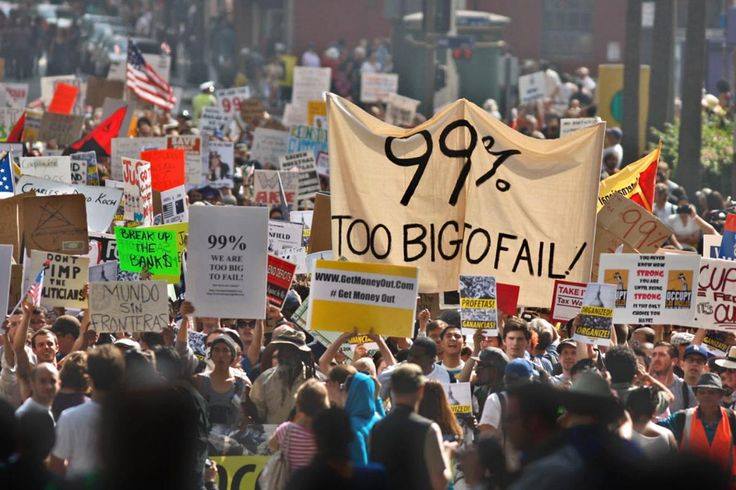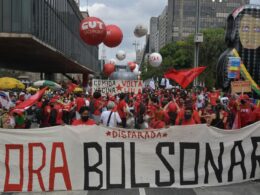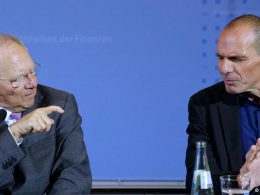The following article is from the Summer issue of Socialist Alternative, the magazine of the Socialist Party.
Decades of neo-liberalism, years of costly foreign wars and a financial bust have created unprecedented levels of social inequality in the world’s dominant capitalist nation. Katia Hancke looks at how these conditions are giving rise to new popular movements and a growing interest in radical, and even socialist, politics.
Seismic shifts politically in the US are challenging the two-party system that has dominated politics for over a century. It is the political expression of a growing section of working class people moving into action to challenge the status quo. Capitalism as a system for the 1% is starting to be questioned and developing, is an openness to socialist ideas.
Both the Democratic and Republican primaries have exposed the growing rejection of Wall Street politics. By far, the biggest group of voters, 45% of the electorate, identify as “independent” – and this number has been steadily increasing from 32% just eight years ago.
The Republican and Democratic party leaderships are scrambling to keep control over their own parties. The US establishment can no longer pretend that the process that has been developing across Europe for a decade or more – of the traditional parties becoming more and more discredited and losing popular support – is not affecting US politics. The era of politics in the US being under full control of the establishment is coming to an end.
The most unequal country
The polarisation in US politics is an expression of an economic polarisation that has continued apace ever since the neo-liberal assaults of Reaganomics, namely a decimation of the organised labour movement; a sustained attack on workers’ rights; a significant reduction of the role the state plays in the economy; and blatant pro-big business policies. Traditional industries and the manufacturing base, especially in what was known as the “Rust Belt” in the Mid West, were destroyed. The jobs that replaced them were more insecure and lower paid.
Concretely, in 2014 over three million workers in the US earned on or below the federal minimum wage of $7.25 per hour. Trying to survive on less than $15,000 a year in a country with no safety net, forces many to work two or even three jobs. Women workers are almost twice as likely as male workers to find themselves at the bottom of the labour market (5% of female workers are paid $7.25 or less, compared to 3% of male workers). The lowest paying sector in the economy is leisure and hospitality, with 18% of workers paid on or below the minimum wage. This sector is the fastest growing in the economy.
While income inequality remained more or less steady from the Second World War to the 1970s, from 1980 onwards, income disparities have skyrocketed to levels last seen in the Roaring Twenties – the era of Rockefeller, Carnegie and ominously, the Great Crash.
America’s top one percent holds nearly half the national wealth invested in stocks and mutual funds. Meanwhile, Americans in the bottom 90 percent hold almost three-quarters of America’s debt.
Return of the Depression
A picture emerges of a country divided into a tiny elite that has rapidly become obscenely rich at the expense of the 99%. The 400 richest Americans have as much wealth as all of the African-American population (16 million) and a third of the Latino population (5 million) combined.
The consequence of neo-liberalism being pushed on such a scale was the global crash of 2008. Driving down wages, attacking workers’ rights and establishing corporate free trade may have restored profitability in the short term, but the hoarding of such levels of profits by such a small elite triggered the biggest crisis since 1929.
The effects on the American working class have been devastating: 62% of Americans have less than $1,000 in savings (the cost of a visit to the emergency room). The bottom 10% of the population are now living significantly shorter lives than the top 10% — the difference in life expectancy is 14 years and growing. The death rate amongst white people aged 25-34 has gone up by 24% over the last 15 years, as suicides increase and drugs hit working class communities hard. For the Black working class, the past decade has brought the biggest loss in wealth since Reconstruction.
The Democrats would like to pretend that after the bailout of the banks and this massive destruction of wealth for the majority of the population, stimulus packages readdressed the balance. But in reality, austerity continues unabated since 2010. For example, massive cuts to public education forces hundreds of thousands of school staff out of a job.
New movements express a deep discontent
With the emergence of the Occupy movement in late 2011, this deep divide between super-rich and the vast majority of the population was popularised under the banner of “the 99%” in contradistinction to the super-rich 1%. The initial occupations were suppressed by early 2012, but the broad popularity and active support for Occupy was striking. Rooted in a response to the right wing offensive, including the setting up of the Tea Party in 2010, Occupy’s popularity far outstripped the latter. It led to an increase in local struggles continuing in the same spirit – against foreclosures, school privatisations but also environmental and anti-racist struggles. More broadly, the Occupy mood led millions to question the establishment – the banks and the financial elite, but also the political elite who are so blatantly and unapologetically their representatives.
Socialist Alternative (SA), the sister organisation of the Socialist Party in the US, recognised early on how significant Occupy was – that it presented an opportunity to break wide open the two party political system as, for a broader layer, it clarified the need for political representation of the 99%. SA turned that analysis into a concrete demand by calling for 200 Occupy candidates to run for election. Kshama Sawant, a member of SA, who stood on a platform of linking the Occupy movement, and the 15 Now movement, into a political struggle against the 1%, was one of those candidates and got elected in Seattle in 2013.
The struggle for a $15 minimum wage, initiated by striking fast food workers, further expressed this mood and helped to keep the question of inequality firmly on the agenda. The breakthrough victory for 15 Now in Seattle, on the back of Kshama Sawant’s election to the Council, laid the basis for a series of victories in other cities and states such as San Francisco, Los Angeles, California and New York.
At the same time, anger exploded against institutional racism and police brutality gripping large sections of Black working class youth. It is a revival of the Civil Rights Movement on a scale not seen since the late 1960s and is playing a significant role in further undermining the political institutions of US capitalism. While racism in the white population overall is at historically low levels and attitudes are changing for the better, institutional racism has remained entrenched – just look at the bias in police murders, the income gap, the mass incarceration demographics. Black Lives Matter (BLM) shows that this contradiction and ongoing injustice leads to struggle and points clearly to the fact that fighting racism is not just about changing opinions, it is about challenging the institutions of US capitalism that have and continue to use racism as a means to divide the working class.
This progressive change in public opinion also expresses itself in a developing movement of women and LGBTQ people challenging sexism and all oppression on the basis of gender or sexuality. The same younger generation is equally being radicalised by the blatant destruction of the environment in the pursuit of profit by big business – the poisoning of the water supply in the town of Flint has drawn national and international attention to what big business is allowed to get away with by the establishment.
Socialist ideas break through
The potential is there for all these movements to combine into a more generalised anti-capitalist challenge. The success of Bernie Sanders’ campaign was based on this potential, as it was in many ways a political expression of all these movements.
There were earlier indications that the struggles and social movements from below, such as Occupy, BLM and 15 Now, reflected a widespread political alienation and a thirst for radical change. The stunning election victory of Kshama Sawant in Seattle in 2013, as a voice for the working class that stands against the 1%, proved that the discontent expressed in a myriad of local struggles when given a political voice can garner mass support. Even more importantly, it proved that even in the US, so often portrayed as “the bastion of capitalism”, a socialist can win broad support for her ideas. Kshama is the first elected socialist in the US in decades, who showed how an electoral position can be used, not just to support and win victories for working class struggles such as 15 Now, but also to popularise socialist ideas.
This chimes with the growing openness, especially amongst young people, for a political alternative to capitalism. Fifty three percent of people under 35 have favourable views of socialism, and 69% of them say they are willing to vote for a socialist presidential candidate. A new generation right across the US acknowledges unbridled US neo-liberalism is bankrupt and cannot deliver even basic rights such as housing, jobs, education or healthcare. A majority of millennials now favour state (as opposed to private sector) involvement in services such as health, third-level education and jobs. Those demands are even more popular amongst young women and people of colour, those most affected by neo-liberalism and austerity.
The Sanders political uprising
Bernie Sanders’ campaign has proven this point on a continent-wide scale. The self-described socialist, who took on the ultimate Wall Street Democrat, Hillary Clinton, saw his campaign transform into a movement for a ‘political revolution against the billionaire class’. Socialist Alternative, having proven the possibility of building such a movement in Seattle, saw the potential for this to happen. While being honest about our differences with Sanders – he should have run as an independent rather than allow himself to be shackled by the claws of the Democratic establishment, the unrealistic nature of his proposals to break up the banks without challenging the ownership of finance capital and his foreign policies (e.g. his support for the Israeli state) – we welcomed his candidacy, seeing its significance and orientating towards the movement that developed around his radical demands.
Even though Sanders’ policies in reality stay within the confines of capitalism and at best look to reform a rotten system rather than replace it, they stand in sharp contrast to Clinton’s shameless corporate politics. Reforms such as single-payer health insurance, tuition free public college, a $15 minimum wage, a steep carbon tax, a big expansion of Social Security, and $1 trillion investment in new infrastructure were seen as a radical alternative to the cosy consensus that made “the richest country in the world” the most unequal country on the globe.
But the strongest appeal in his campaign was the clarity with which he called out the control that Wall Street exercises over America’s entire political system. His refusal to accept donations from big business was deeply respected and hugely popular, and his campaign raised an unprecedented $222 million from small donations. Sanders rallies attracted tens of thousands of people in every city and county. His call for a political revolution turned into a movement that developed its own momentum. If Sanders had decided to run as an independent, instead of confining himself to the straitjacket of a hostile Democratic Party, this movement could have gone much further in challenging the status quo and offering a real alternative to the rise of populist, bigoted, right-wing figures such as Donald Trump.
As it is, Hillary Clinton was able to hang on to the Democratic nomination thanks to the support of “super” delegates, but in the process she exposed just how undemocratic the primary process is and how much it is stacked in favour of the establishment candidate through the huge power of superdelegates and other blatantly undemocratic measures.
As the movement around Sanders’ grew, he was pushed to the left. Hundreds of thousands of people came to his rallies, millions contributed to his campaign fund, inspired by a radical alternative to the establishment. Poll after poll confirmed that he is by far the most trusted candidate to defeat Trump. If he had decided to run on a joint ticket with Jill Stein, from the American Green Party, this campaign would have grown further and would have opened up the concrete conditions for the launch of a party of the 99%. Even though Sanders unfortunately will not run as an independent in the presidential elections, the lesser known Jill Stein is polling at six-seven percent, which again shows the potential for a left-wing alternative to gain significant ground across the US. Sanders’ campaign, despite his own unfortunate decision to stick with the Democrats, has opened up a vista of thousands of independents running for election at state and council level in the coming years. The Democratic Party is facing a challenge from the left that will not go away.
Republicans in turmoil
The flip side of this growing polarisation and alienation from the political establishment can be witnessed in the Republican Party, whose leadership are equally struggling to keep control over their party. The rapid rise of the Tea Party within the Grand Old Party (GOP), in response to Obama’s election victory in 2008, reflected the deep disillusionment amongst significant sections of the middle class. The Tea Party and a deep distrust of the GOP establishment, laid the basis for the rise of a racist, misogynistic bigot to become the presidential candidate of the oldest party of capital in the US.
Donald Trump is not the preferred candidate of the 1%. There is the obvious fact that he is a maverick who is not under the control of the party leadership and therefore seen as a liability. But there is more to it than that.
A recent survey shows that millionaires overwhelmingly support Hillary Clinton over Trump, even though the Republican Party traditionally gets much stronger support amongst this group than the Democratic Party. For example, Apple have decided to not support the Republican Convention this year due to their unease over Trump’s continued attacks on their manufacturing base in China.
Even Charles Koch, arch conservative and one of the biggest funders of the Tea Party, has come out against Trump saying he “will destroy free society”. Is this because Koch is horrified at Trump’s racism? His disrespect for women? His hatred of the LGBTQ community? Clearly not – the Tea Party have quite a long record of doing exactly all that for quite some time. The “free society” Koch & Co. are afraid of losing is the unbridled neo-liberalism of corporate trade deals such as NAFTA, TTIP and TPP.
Economic insecurity stokes fear
After NAFTA was introduced,more than one million net jobs were lost in the US between 1994 and 2004. Of the manufacturing workers who did manage to find other employment, over two-thirds had to put up with a wage reduction of over 20%. The downward pressure on wages is even more pronounced in Mexico, feeding a stream of desperate migrants trying to eke out a living in the US. US corporations are more than happy to embrace this cheap source of labour.
While NAFTA and free trade has been good to multinationals and big corporations, it has hurt the working class and middle class – and they know it. Fifty three percent of Americans believe the U.S. should “do whatever is necessary” to “renegotiate” or “leave” NAFTA.5 The opposition to and suspicion of further trade agreements such as TTIP and TPP is widespread.
In that context it is no wonder that Trump’s message gains significant support amongst many older white men in the middle and working class. Based on a combination of scapegoating immigrants, unions, women, LGBTQ people and people of colour on one hand, and a “new” version of political isolationism and protectionist, anti-globalisation rhetoric on the other, the Trump phenomenon is part of the rise of right-wing populist forces not just in the US, but also across Europe.
The mainstream media often tries to portray Trump supporters as angry, uneducated, working class fools. An analysis of his core support paints a different picture: while 55 percent of Trump supporters do not have a degree, this is significantly below the national figure of 70 percent. A general trend is that Trump gains support as the wealth scale moves upward. For instance, in the New York primaries, Trump support was at 52 percent from those earning $50,000 a year or less, but increased to 63 percent from those earning over $100,000.
The Republican Party traditionally has stronger support amongst those earning $50,000 or more – reflecting their stronger traditional base of support amongst the middle and upper class. Furthermore, the support for right-wing populism is indicated to be strongest amongst middle management, small business owners and self-employed people, they have seen their real income stagnate or drop over the last decade while wealth inequality increased. Their businesses were hit during the recession and despite talk of economic recovery, there is not much proof of that in their purses. They are unsure about their pension funds which were decimated in the banking collapse, the value of their homes have come crashing down and left them with untenable personal debt – they worry about how they will put their children through college.
But where a younger, more multicultural, diverse and outward looking generation has been radicalised by these experiences and is increasingly looking towards struggle and a political alternative to challenge the status quo, this older, mainly male and middle class demographic is taken in by the cheap rhetoric of a billionaire posing as a man of the people; a failed businessman who will make “America great again”; a rich kid and reality TV star posing as a “strong leader” who understands “ordinary people”. As much as the European media tries to portray the Trump phenomenon as uniquely American, there are obvious parallels with right-wing populist and far-right movements in Europe such as UKIP in England, Marie Le Pen’s Front National in France, Geert Wilders’ Party for Freedom in the Netherlands or Pegida in Germany.
A change is gonna come
The antidote is the development of movements such as 15 Now, BLM and Occupy that has seen a new generation move into struggle and draw political conclusions. The end of the “American Dream”, a crisis of legitimacy for capitalism and its institutions and the weakening position of US imperialism has created the most favourable situation in decades for a new broad left force to develop and for the forces of socialism to be significantly strengthened.
The Sanders movement was a lighting rod for the desire for radical change among broad sections of the US working class. The inability of capitalism to provide even the basic rights and needs for the majority, while the astronomical wealth of the 1% continues to increase, has created the conditions for further explosive developments, mass movements and political shocks in the “belly of the beast” that will reverberate across the world.












